Health Informatics: Current Issues and Challenges in Healthcare
VerifiedAdded on 2023/04/24
|9
|2107
|496
Report
AI Summary
This report provides a comprehensive overview of the current issues and challenges in health informatics, with a specific focus on the usage of Electronic Health Records (EHRs) and their impact on nursing practices. The report delves into the various issues faced by nurses, such as low satisfaction with EHR usage, technical glitches, and the shift in their clinical role towards continuous documentation, potentially hindering patient-centered care. It examines the effects of health informatics on the nursing profession, highlighting both improvements in documentation and communication and the potential for reduced nurse-patient interaction. The report also explores intervention strategies, including the implementation of patient-centered care, establishing communication with IT personnel, and providing educational tools for EHR usage, to mitigate the challenges associated with health informatics and improve nursing competence. The rationale for these interventions is discussed, along with methods for evaluating their effectiveness. The report concludes by emphasizing the importance of addressing these issues to optimize healthcare delivery and enhance nursing practices in the age of digital health.
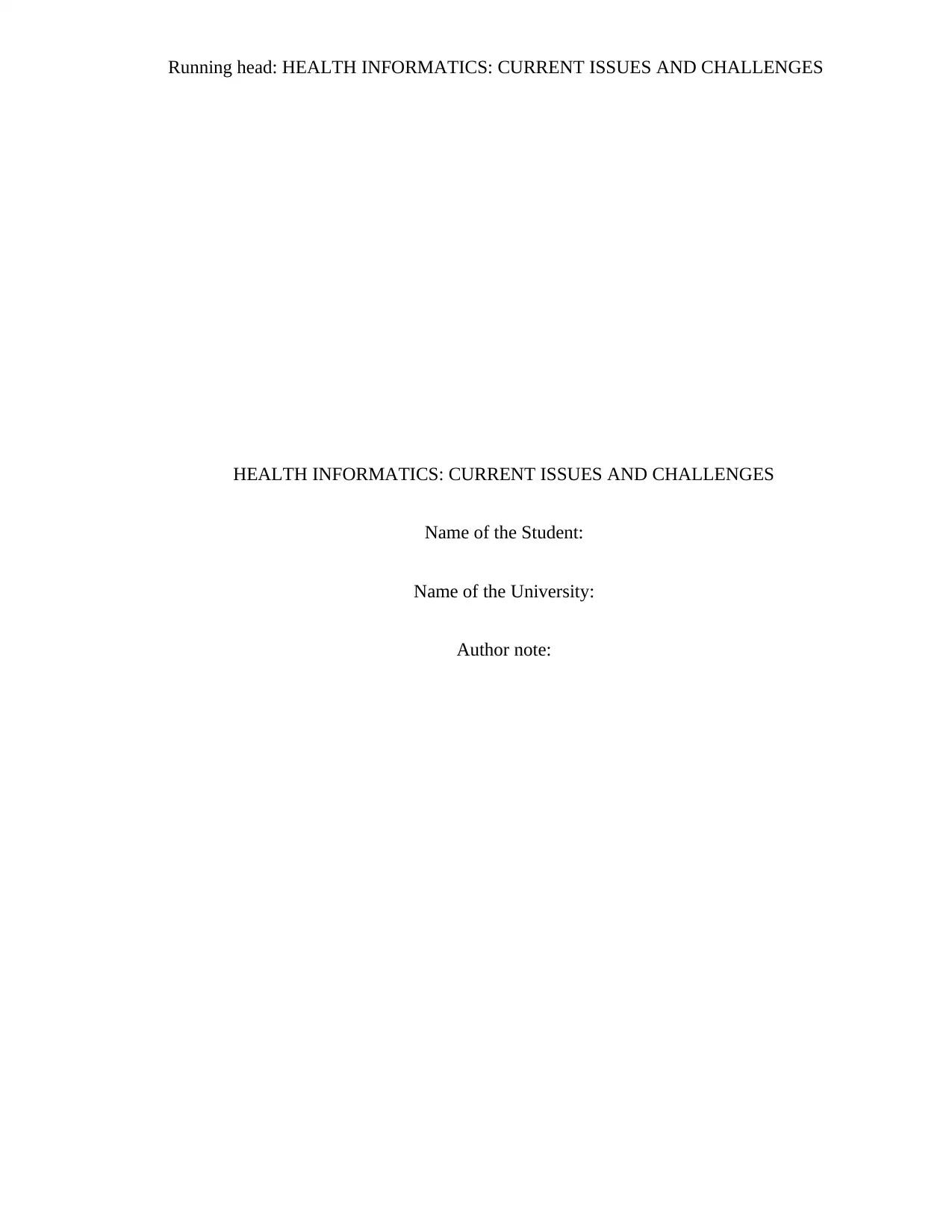
Running head: HEALTH INFORMATICS: CURRENT ISSUES AND CHALLENGES
HEALTH INFORMATICS: CURRENT ISSUES AND CHALLENGES
Name of the Student:
Name of the University:
Author note:
HEALTH INFORMATICS: CURRENT ISSUES AND CHALLENGES
Name of the Student:
Name of the University:
Author note:
Paraphrase This Document
Need a fresh take? Get an instant paraphrase of this document with our AI Paraphraser
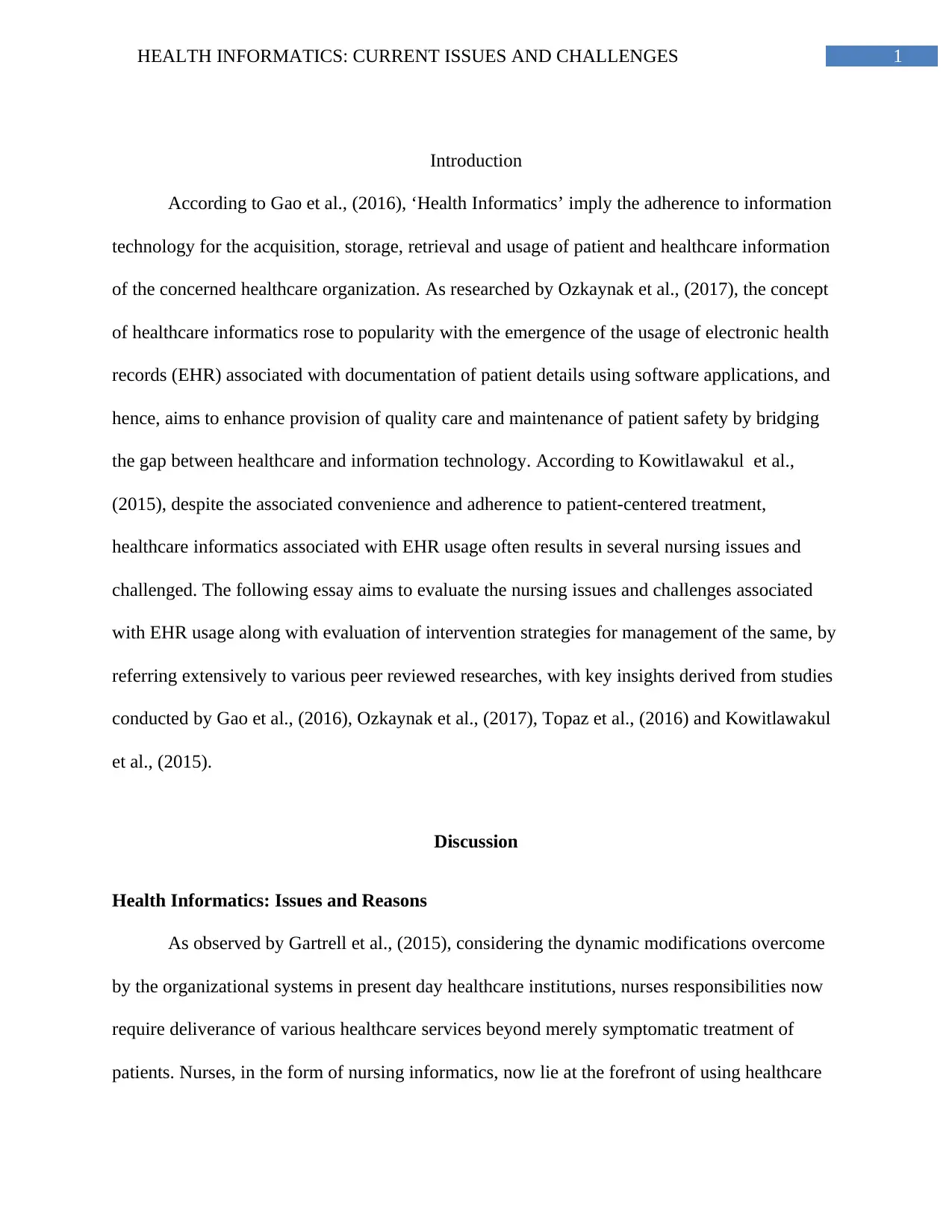
1HEALTH INFORMATICS: CURRENT ISSUES AND CHALLENGES
Introduction
According to Gao et al., (2016), ‘Health Informatics’ imply the adherence to information
technology for the acquisition, storage, retrieval and usage of patient and healthcare information
of the concerned healthcare organization. As researched by Ozkaynak et al., (2017), the concept
of healthcare informatics rose to popularity with the emergence of the usage of electronic health
records (EHR) associated with documentation of patient details using software applications, and
hence, aims to enhance provision of quality care and maintenance of patient safety by bridging
the gap between healthcare and information technology. According to Kowitlawakul et al.,
(2015), despite the associated convenience and adherence to patient-centered treatment,
healthcare informatics associated with EHR usage often results in several nursing issues and
challenged. The following essay aims to evaluate the nursing issues and challenges associated
with EHR usage along with evaluation of intervention strategies for management of the same, by
referring extensively to various peer reviewed researches, with key insights derived from studies
conducted by Gao et al., (2016), Ozkaynak et al., (2017), Topaz et al., (2016) and Kowitlawakul
et al., (2015).
Discussion
Health Informatics: Issues and Reasons
As observed by Gartrell et al., (2015), considering the dynamic modifications overcome
by the organizational systems in present day healthcare institutions, nurses responsibilities now
require deliverance of various healthcare services beyond merely symptomatic treatment of
patients. Nurses, in the form of nursing informatics, now lie at the forefront of using healthcare
Introduction
According to Gao et al., (2016), ‘Health Informatics’ imply the adherence to information
technology for the acquisition, storage, retrieval and usage of patient and healthcare information
of the concerned healthcare organization. As researched by Ozkaynak et al., (2017), the concept
of healthcare informatics rose to popularity with the emergence of the usage of electronic health
records (EHR) associated with documentation of patient details using software applications, and
hence, aims to enhance provision of quality care and maintenance of patient safety by bridging
the gap between healthcare and information technology. According to Kowitlawakul et al.,
(2015), despite the associated convenience and adherence to patient-centered treatment,
healthcare informatics associated with EHR usage often results in several nursing issues and
challenged. The following essay aims to evaluate the nursing issues and challenges associated
with EHR usage along with evaluation of intervention strategies for management of the same, by
referring extensively to various peer reviewed researches, with key insights derived from studies
conducted by Gao et al., (2016), Ozkaynak et al., (2017), Topaz et al., (2016) and Kowitlawakul
et al., (2015).
Discussion
Health Informatics: Issues and Reasons
As observed by Gartrell et al., (2015), considering the dynamic modifications overcome
by the organizational systems in present day healthcare institutions, nurses responsibilities now
require deliverance of various healthcare services beyond merely symptomatic treatment of
patients. Nurses, in the form of nursing informatics, now lie at the forefront of using healthcare
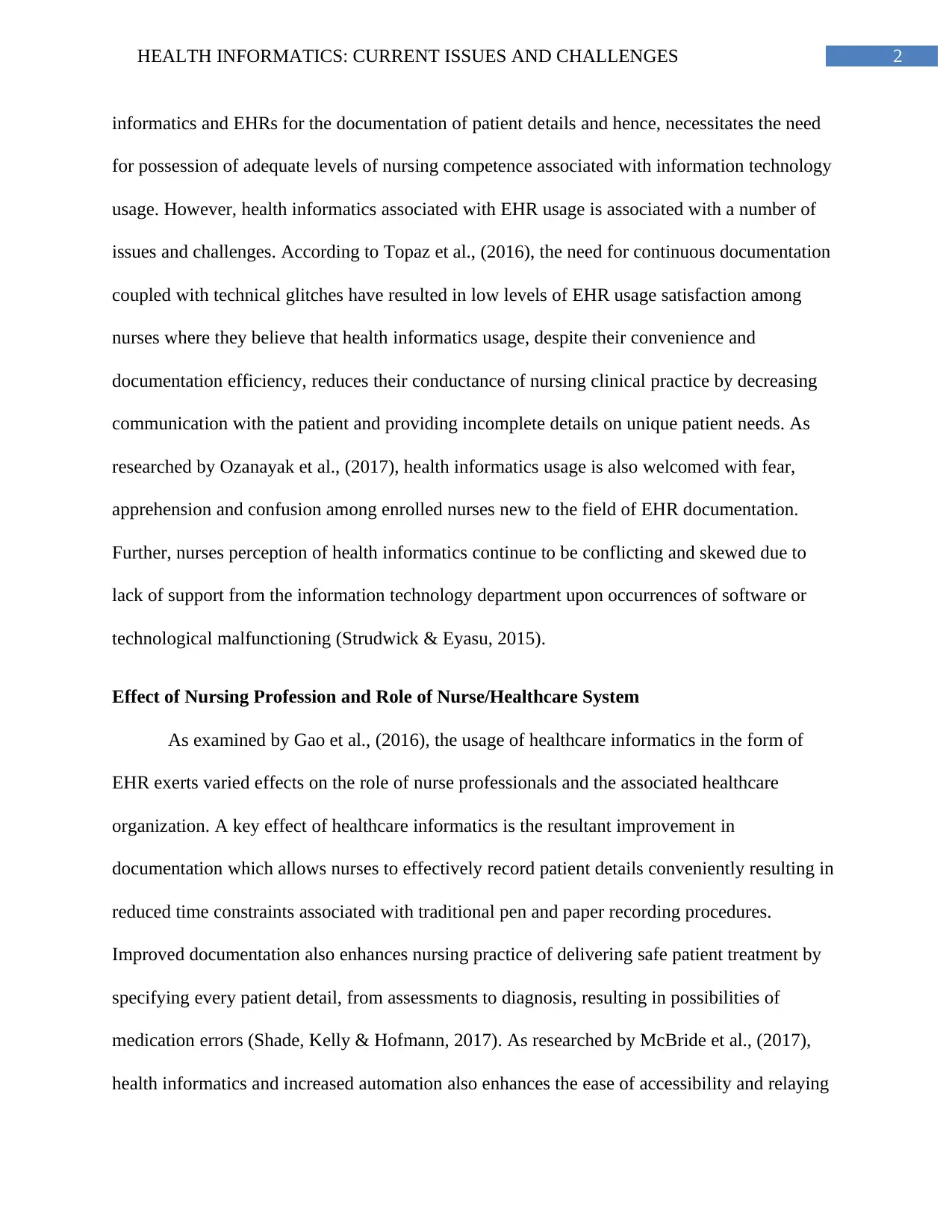
2HEALTH INFORMATICS: CURRENT ISSUES AND CHALLENGES
informatics and EHRs for the documentation of patient details and hence, necessitates the need
for possession of adequate levels of nursing competence associated with information technology
usage. However, health informatics associated with EHR usage is associated with a number of
issues and challenges. According to Topaz et al., (2016), the need for continuous documentation
coupled with technical glitches have resulted in low levels of EHR usage satisfaction among
nurses where they believe that health informatics usage, despite their convenience and
documentation efficiency, reduces their conductance of nursing clinical practice by decreasing
communication with the patient and providing incomplete details on unique patient needs. As
researched by Ozanayak et al., (2017), health informatics usage is also welcomed with fear,
apprehension and confusion among enrolled nurses new to the field of EHR documentation.
Further, nurses perception of health informatics continue to be conflicting and skewed due to
lack of support from the information technology department upon occurrences of software or
technological malfunctioning (Strudwick & Eyasu, 2015).
Effect of Nursing Profession and Role of Nurse/Healthcare System
As examined by Gao et al., (2016), the usage of healthcare informatics in the form of
EHR exerts varied effects on the role of nurse professionals and the associated healthcare
organization. A key effect of healthcare informatics is the resultant improvement in
documentation which allows nurses to effectively record patient details conveniently resulting in
reduced time constraints associated with traditional pen and paper recording procedures.
Improved documentation also enhances nursing practice of delivering safe patient treatment by
specifying every patient detail, from assessments to diagnosis, resulting in possibilities of
medication errors (Shade, Kelly & Hofmann, 2017). As researched by McBride et al., (2017),
health informatics and increased automation also enhances the ease of accessibility and relaying
informatics and EHRs for the documentation of patient details and hence, necessitates the need
for possession of adequate levels of nursing competence associated with information technology
usage. However, health informatics associated with EHR usage is associated with a number of
issues and challenges. According to Topaz et al., (2016), the need for continuous documentation
coupled with technical glitches have resulted in low levels of EHR usage satisfaction among
nurses where they believe that health informatics usage, despite their convenience and
documentation efficiency, reduces their conductance of nursing clinical practice by decreasing
communication with the patient and providing incomplete details on unique patient needs. As
researched by Ozanayak et al., (2017), health informatics usage is also welcomed with fear,
apprehension and confusion among enrolled nurses new to the field of EHR documentation.
Further, nurses perception of health informatics continue to be conflicting and skewed due to
lack of support from the information technology department upon occurrences of software or
technological malfunctioning (Strudwick & Eyasu, 2015).
Effect of Nursing Profession and Role of Nurse/Healthcare System
As examined by Gao et al., (2016), the usage of healthcare informatics in the form of
EHR exerts varied effects on the role of nurse professionals and the associated healthcare
organization. A key effect of healthcare informatics is the resultant improvement in
documentation which allows nurses to effectively record patient details conveniently resulting in
reduced time constraints associated with traditional pen and paper recording procedures.
Improved documentation also enhances nursing practice of delivering safe patient treatment by
specifying every patient detail, from assessments to diagnosis, resulting in possibilities of
medication errors (Shade, Kelly & Hofmann, 2017). As researched by McBride et al., (2017),
health informatics and increased automation also enhances the ease of accessibility and relaying
⊘ This is a preview!⊘
Do you want full access?
Subscribe today to unlock all pages.

Trusted by 1+ million students worldwide
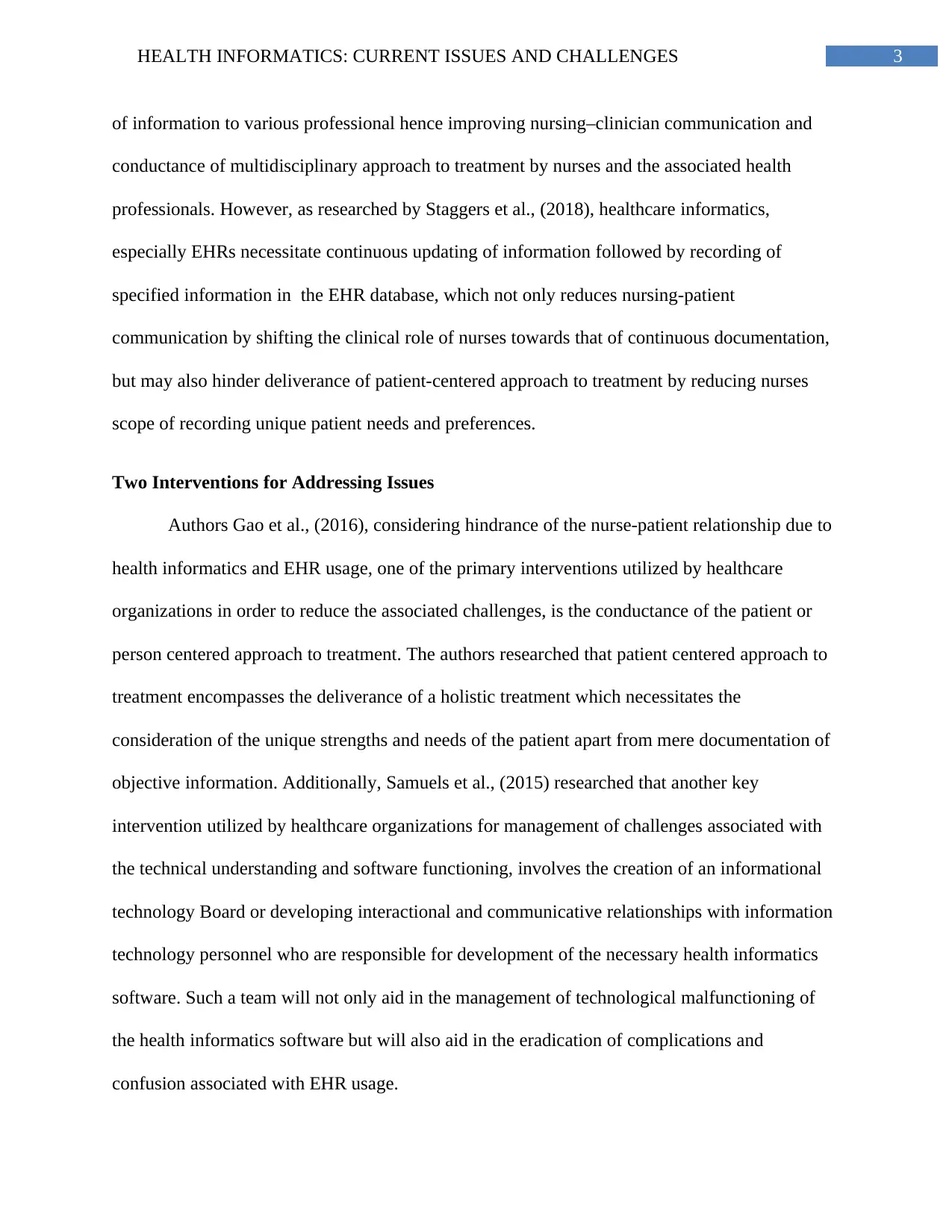
3HEALTH INFORMATICS: CURRENT ISSUES AND CHALLENGES
of information to various professional hence improving nursing–clinician communication and
conductance of multidisciplinary approach to treatment by nurses and the associated health
professionals. However, as researched by Staggers et al., (2018), healthcare informatics,
especially EHRs necessitate continuous updating of information followed by recording of
specified information in the EHR database, which not only reduces nursing-patient
communication by shifting the clinical role of nurses towards that of continuous documentation,
but may also hinder deliverance of patient-centered approach to treatment by reducing nurses
scope of recording unique patient needs and preferences.
Two Interventions for Addressing Issues
Authors Gao et al., (2016), considering hindrance of the nurse-patient relationship due to
health informatics and EHR usage, one of the primary interventions utilized by healthcare
organizations in order to reduce the associated challenges, is the conductance of the patient or
person centered approach to treatment. The authors researched that patient centered approach to
treatment encompasses the deliverance of a holistic treatment which necessitates the
consideration of the unique strengths and needs of the patient apart from mere documentation of
objective information. Additionally, Samuels et al., (2015) researched that another key
intervention utilized by healthcare organizations for management of challenges associated with
the technical understanding and software functioning, involves the creation of an informational
technology Board or developing interactional and communicative relationships with information
technology personnel who are responsible for development of the necessary health informatics
software. Such a team will not only aid in the management of technological malfunctioning of
the health informatics software but will also aid in the eradication of complications and
confusion associated with EHR usage.
of information to various professional hence improving nursing–clinician communication and
conductance of multidisciplinary approach to treatment by nurses and the associated health
professionals. However, as researched by Staggers et al., (2018), healthcare informatics,
especially EHRs necessitate continuous updating of information followed by recording of
specified information in the EHR database, which not only reduces nursing-patient
communication by shifting the clinical role of nurses towards that of continuous documentation,
but may also hinder deliverance of patient-centered approach to treatment by reducing nurses
scope of recording unique patient needs and preferences.
Two Interventions for Addressing Issues
Authors Gao et al., (2016), considering hindrance of the nurse-patient relationship due to
health informatics and EHR usage, one of the primary interventions utilized by healthcare
organizations in order to reduce the associated challenges, is the conductance of the patient or
person centered approach to treatment. The authors researched that patient centered approach to
treatment encompasses the deliverance of a holistic treatment which necessitates the
consideration of the unique strengths and needs of the patient apart from mere documentation of
objective information. Additionally, Samuels et al., (2015) researched that another key
intervention utilized by healthcare organizations for management of challenges associated with
the technical understanding and software functioning, involves the creation of an informational
technology Board or developing interactional and communicative relationships with information
technology personnel who are responsible for development of the necessary health informatics
software. Such a team will not only aid in the management of technological malfunctioning of
the health informatics software but will also aid in the eradication of complications and
confusion associated with EHR usage.
Paraphrase This Document
Need a fresh take? Get an instant paraphrase of this document with our AI Paraphraser
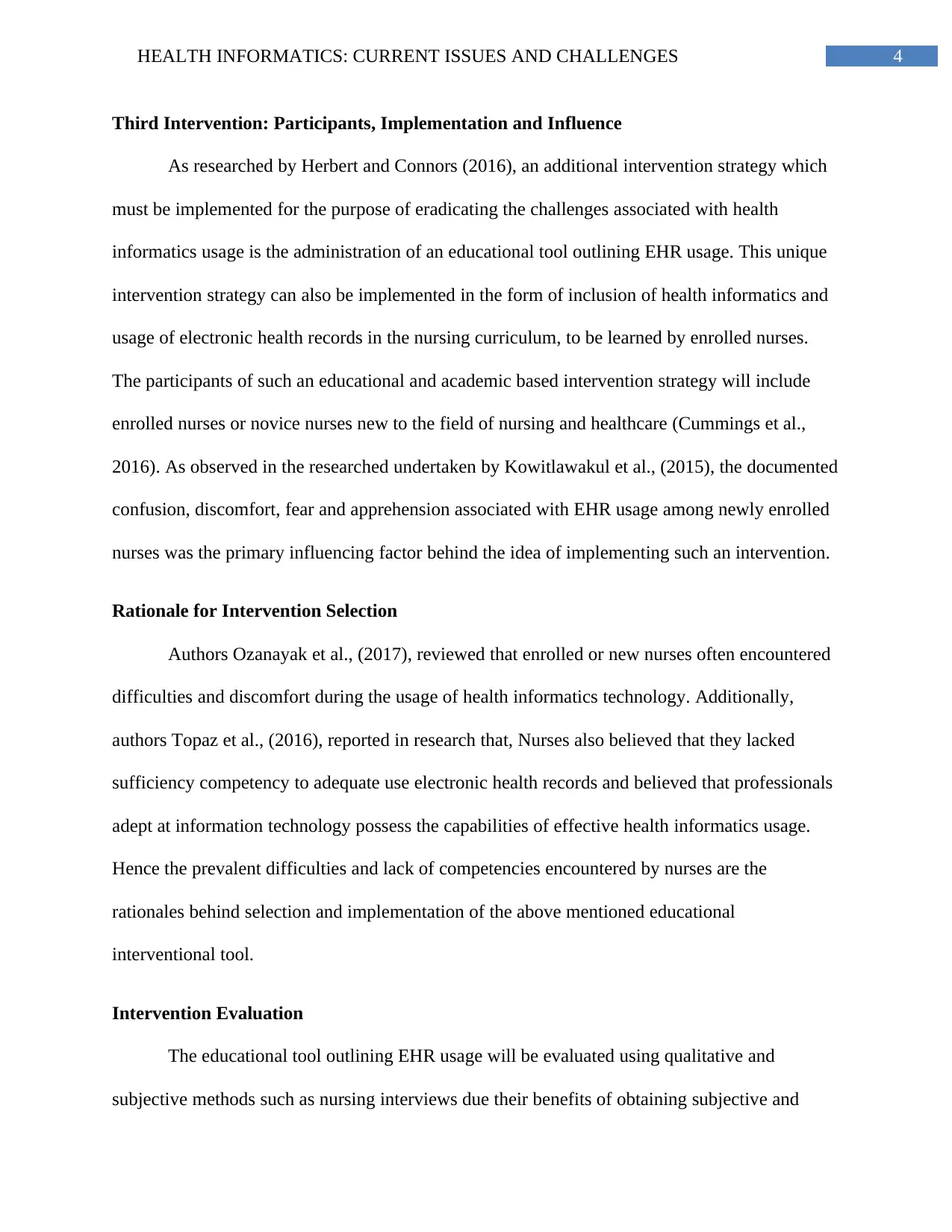
4HEALTH INFORMATICS: CURRENT ISSUES AND CHALLENGES
Third Intervention: Participants, Implementation and Influence
As researched by Herbert and Connors (2016), an additional intervention strategy which
must be implemented for the purpose of eradicating the challenges associated with health
informatics usage is the administration of an educational tool outlining EHR usage. This unique
intervention strategy can also be implemented in the form of inclusion of health informatics and
usage of electronic health records in the nursing curriculum, to be learned by enrolled nurses.
The participants of such an educational and academic based intervention strategy will include
enrolled nurses or novice nurses new to the field of nursing and healthcare (Cummings et al.,
2016). As observed in the researched undertaken by Kowitlawakul et al., (2015), the documented
confusion, discomfort, fear and apprehension associated with EHR usage among newly enrolled
nurses was the primary influencing factor behind the idea of implementing such an intervention.
Rationale for Intervention Selection
Authors Ozanayak et al., (2017), reviewed that enrolled or new nurses often encountered
difficulties and discomfort during the usage of health informatics technology. Additionally,
authors Topaz et al., (2016), reported in research that, Nurses also believed that they lacked
sufficiency competency to adequate use electronic health records and believed that professionals
adept at information technology possess the capabilities of effective health informatics usage.
Hence the prevalent difficulties and lack of competencies encountered by nurses are the
rationales behind selection and implementation of the above mentioned educational
interventional tool.
Intervention Evaluation
The educational tool outlining EHR usage will be evaluated using qualitative and
subjective methods such as nursing interviews due their benefits of obtaining subjective and
Third Intervention: Participants, Implementation and Influence
As researched by Herbert and Connors (2016), an additional intervention strategy which
must be implemented for the purpose of eradicating the challenges associated with health
informatics usage is the administration of an educational tool outlining EHR usage. This unique
intervention strategy can also be implemented in the form of inclusion of health informatics and
usage of electronic health records in the nursing curriculum, to be learned by enrolled nurses.
The participants of such an educational and academic based intervention strategy will include
enrolled nurses or novice nurses new to the field of nursing and healthcare (Cummings et al.,
2016). As observed in the researched undertaken by Kowitlawakul et al., (2015), the documented
confusion, discomfort, fear and apprehension associated with EHR usage among newly enrolled
nurses was the primary influencing factor behind the idea of implementing such an intervention.
Rationale for Intervention Selection
Authors Ozanayak et al., (2017), reviewed that enrolled or new nurses often encountered
difficulties and discomfort during the usage of health informatics technology. Additionally,
authors Topaz et al., (2016), reported in research that, Nurses also believed that they lacked
sufficiency competency to adequate use electronic health records and believed that professionals
adept at information technology possess the capabilities of effective health informatics usage.
Hence the prevalent difficulties and lack of competencies encountered by nurses are the
rationales behind selection and implementation of the above mentioned educational
interventional tool.
Intervention Evaluation
The educational tool outlining EHR usage will be evaluated using qualitative and
subjective methods such as nursing interviews due their benefits of obtaining subjective and
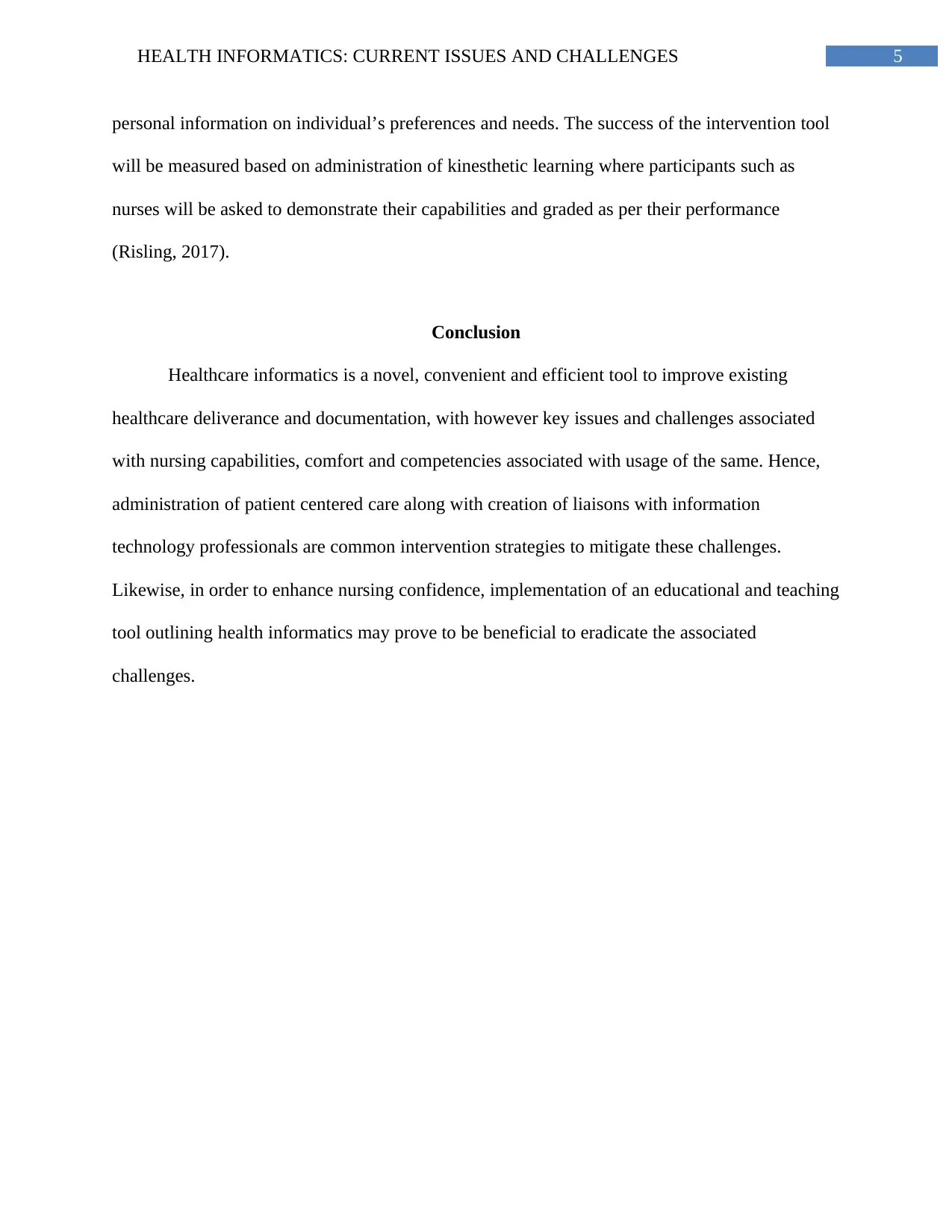
5HEALTH INFORMATICS: CURRENT ISSUES AND CHALLENGES
personal information on individual’s preferences and needs. The success of the intervention tool
will be measured based on administration of kinesthetic learning where participants such as
nurses will be asked to demonstrate their capabilities and graded as per their performance
(Risling, 2017).
Conclusion
Healthcare informatics is a novel, convenient and efficient tool to improve existing
healthcare deliverance and documentation, with however key issues and challenges associated
with nursing capabilities, comfort and competencies associated with usage of the same. Hence,
administration of patient centered care along with creation of liaisons with information
technology professionals are common intervention strategies to mitigate these challenges.
Likewise, in order to enhance nursing confidence, implementation of an educational and teaching
tool outlining health informatics may prove to be beneficial to eradicate the associated
challenges.
personal information on individual’s preferences and needs. The success of the intervention tool
will be measured based on administration of kinesthetic learning where participants such as
nurses will be asked to demonstrate their capabilities and graded as per their performance
(Risling, 2017).
Conclusion
Healthcare informatics is a novel, convenient and efficient tool to improve existing
healthcare deliverance and documentation, with however key issues and challenges associated
with nursing capabilities, comfort and competencies associated with usage of the same. Hence,
administration of patient centered care along with creation of liaisons with information
technology professionals are common intervention strategies to mitigate these challenges.
Likewise, in order to enhance nursing confidence, implementation of an educational and teaching
tool outlining health informatics may prove to be beneficial to eradicate the associated
challenges.
⊘ This is a preview!⊘
Do you want full access?
Subscribe today to unlock all pages.

Trusted by 1+ million students worldwide
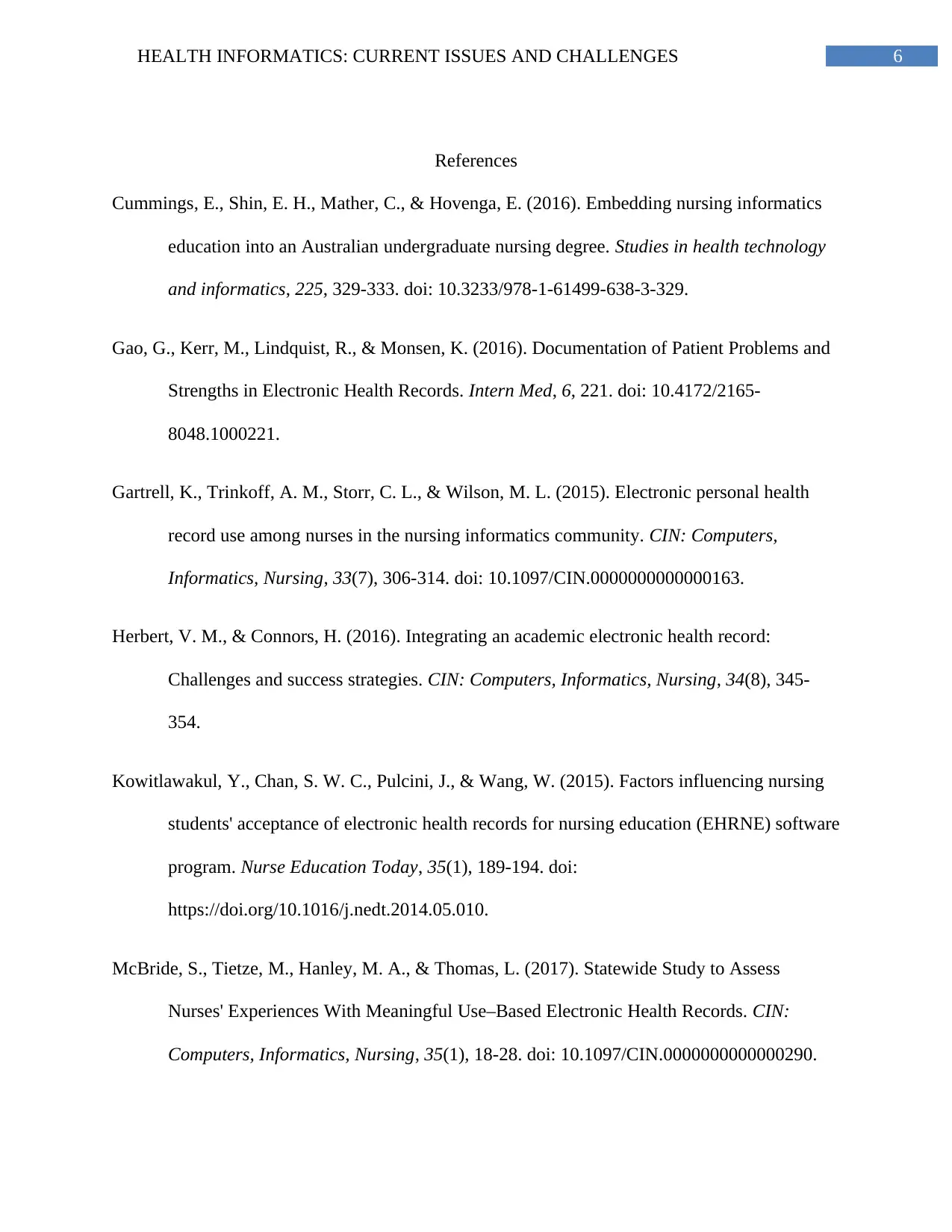
6HEALTH INFORMATICS: CURRENT ISSUES AND CHALLENGES
References
Cummings, E., Shin, E. H., Mather, C., & Hovenga, E. (2016). Embedding nursing informatics
education into an Australian undergraduate nursing degree. Studies in health technology
and informatics, 225, 329-333. doi: 10.3233/978-1-61499-638-3-329.
Gao, G., Kerr, M., Lindquist, R., & Monsen, K. (2016). Documentation of Patient Problems and
Strengths in Electronic Health Records. Intern Med, 6, 221. doi: 10.4172/2165-
8048.1000221.
Gartrell, K., Trinkoff, A. M., Storr, C. L., & Wilson, M. L. (2015). Electronic personal health
record use among nurses in the nursing informatics community. CIN: Computers,
Informatics, Nursing, 33(7), 306-314. doi: 10.1097/CIN.0000000000000163.
Herbert, V. M., & Connors, H. (2016). Integrating an academic electronic health record:
Challenges and success strategies. CIN: Computers, Informatics, Nursing, 34(8), 345-
354.
Kowitlawakul, Y., Chan, S. W. C., Pulcini, J., & Wang, W. (2015). Factors influencing nursing
students' acceptance of electronic health records for nursing education (EHRNE) software
program. Nurse Education Today, 35(1), 189-194. doi:
https://doi.org/10.1016/j.nedt.2014.05.010.
McBride, S., Tietze, M., Hanley, M. A., & Thomas, L. (2017). Statewide Study to Assess
Nurses' Experiences With Meaningful Use–Based Electronic Health Records. CIN:
Computers, Informatics, Nursing, 35(1), 18-28. doi: 10.1097/CIN.0000000000000290.
References
Cummings, E., Shin, E. H., Mather, C., & Hovenga, E. (2016). Embedding nursing informatics
education into an Australian undergraduate nursing degree. Studies in health technology
and informatics, 225, 329-333. doi: 10.3233/978-1-61499-638-3-329.
Gao, G., Kerr, M., Lindquist, R., & Monsen, K. (2016). Documentation of Patient Problems and
Strengths in Electronic Health Records. Intern Med, 6, 221. doi: 10.4172/2165-
8048.1000221.
Gartrell, K., Trinkoff, A. M., Storr, C. L., & Wilson, M. L. (2015). Electronic personal health
record use among nurses in the nursing informatics community. CIN: Computers,
Informatics, Nursing, 33(7), 306-314. doi: 10.1097/CIN.0000000000000163.
Herbert, V. M., & Connors, H. (2016). Integrating an academic electronic health record:
Challenges and success strategies. CIN: Computers, Informatics, Nursing, 34(8), 345-
354.
Kowitlawakul, Y., Chan, S. W. C., Pulcini, J., & Wang, W. (2015). Factors influencing nursing
students' acceptance of electronic health records for nursing education (EHRNE) software
program. Nurse Education Today, 35(1), 189-194. doi:
https://doi.org/10.1016/j.nedt.2014.05.010.
McBride, S., Tietze, M., Hanley, M. A., & Thomas, L. (2017). Statewide Study to Assess
Nurses' Experiences With Meaningful Use–Based Electronic Health Records. CIN:
Computers, Informatics, Nursing, 35(1), 18-28. doi: 10.1097/CIN.0000000000000290.
Paraphrase This Document
Need a fresh take? Get an instant paraphrase of this document with our AI Paraphraser
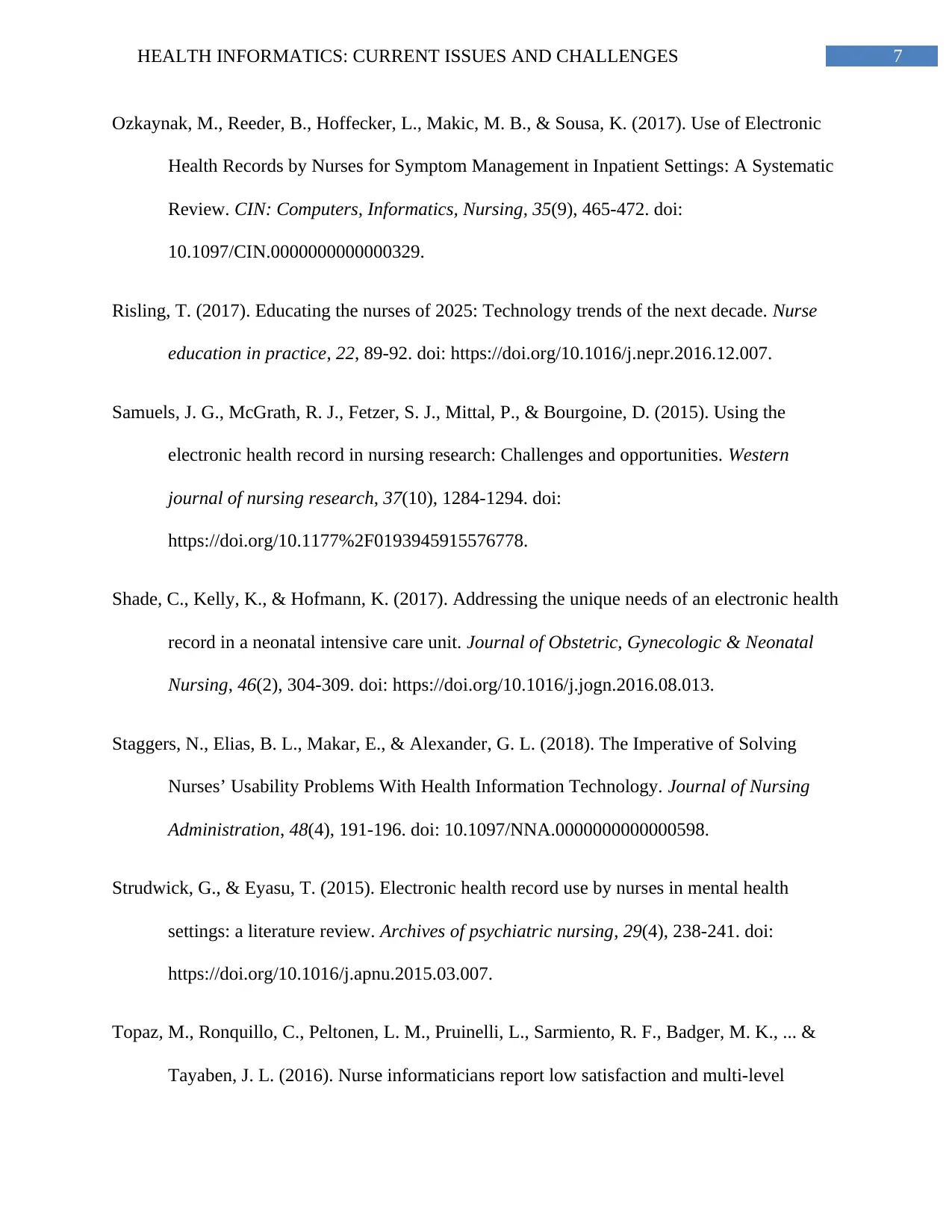
7HEALTH INFORMATICS: CURRENT ISSUES AND CHALLENGES
Ozkaynak, M., Reeder, B., Hoffecker, L., Makic, M. B., & Sousa, K. (2017). Use of Electronic
Health Records by Nurses for Symptom Management in Inpatient Settings: A Systematic
Review. CIN: Computers, Informatics, Nursing, 35(9), 465-472. doi:
10.1097/CIN.0000000000000329.
Risling, T. (2017). Educating the nurses of 2025: Technology trends of the next decade. Nurse
education in practice, 22, 89-92. doi: https://doi.org/10.1016/j.nepr.2016.12.007.
Samuels, J. G., McGrath, R. J., Fetzer, S. J., Mittal, P., & Bourgoine, D. (2015). Using the
electronic health record in nursing research: Challenges and opportunities. Western
journal of nursing research, 37(10), 1284-1294. doi:
https://doi.org/10.1177%2F0193945915576778.
Shade, C., Kelly, K., & Hofmann, K. (2017). Addressing the unique needs of an electronic health
record in a neonatal intensive care unit. Journal of Obstetric, Gynecologic & Neonatal
Nursing, 46(2), 304-309. doi: https://doi.org/10.1016/j.jogn.2016.08.013.
Staggers, N., Elias, B. L., Makar, E., & Alexander, G. L. (2018). The Imperative of Solving
Nurses’ Usability Problems With Health Information Technology. Journal of Nursing
Administration, 48(4), 191-196. doi: 10.1097/NNA.0000000000000598.
Strudwick, G., & Eyasu, T. (2015). Electronic health record use by nurses in mental health
settings: a literature review. Archives of psychiatric nursing, 29(4), 238-241. doi:
https://doi.org/10.1016/j.apnu.2015.03.007.
Topaz, M., Ronquillo, C., Peltonen, L. M., Pruinelli, L., Sarmiento, R. F., Badger, M. K., ... &
Tayaben, J. L. (2016). Nurse informaticians report low satisfaction and multi-level
Ozkaynak, M., Reeder, B., Hoffecker, L., Makic, M. B., & Sousa, K. (2017). Use of Electronic
Health Records by Nurses for Symptom Management in Inpatient Settings: A Systematic
Review. CIN: Computers, Informatics, Nursing, 35(9), 465-472. doi:
10.1097/CIN.0000000000000329.
Risling, T. (2017). Educating the nurses of 2025: Technology trends of the next decade. Nurse
education in practice, 22, 89-92. doi: https://doi.org/10.1016/j.nepr.2016.12.007.
Samuels, J. G., McGrath, R. J., Fetzer, S. J., Mittal, P., & Bourgoine, D. (2015). Using the
electronic health record in nursing research: Challenges and opportunities. Western
journal of nursing research, 37(10), 1284-1294. doi:
https://doi.org/10.1177%2F0193945915576778.
Shade, C., Kelly, K., & Hofmann, K. (2017). Addressing the unique needs of an electronic health
record in a neonatal intensive care unit. Journal of Obstetric, Gynecologic & Neonatal
Nursing, 46(2), 304-309. doi: https://doi.org/10.1016/j.jogn.2016.08.013.
Staggers, N., Elias, B. L., Makar, E., & Alexander, G. L. (2018). The Imperative of Solving
Nurses’ Usability Problems With Health Information Technology. Journal of Nursing
Administration, 48(4), 191-196. doi: 10.1097/NNA.0000000000000598.
Strudwick, G., & Eyasu, T. (2015). Electronic health record use by nurses in mental health
settings: a literature review. Archives of psychiatric nursing, 29(4), 238-241. doi:
https://doi.org/10.1016/j.apnu.2015.03.007.
Topaz, M., Ronquillo, C., Peltonen, L. M., Pruinelli, L., Sarmiento, R. F., Badger, M. K., ... &
Tayaben, J. L. (2016). Nurse informaticians report low satisfaction and multi-level
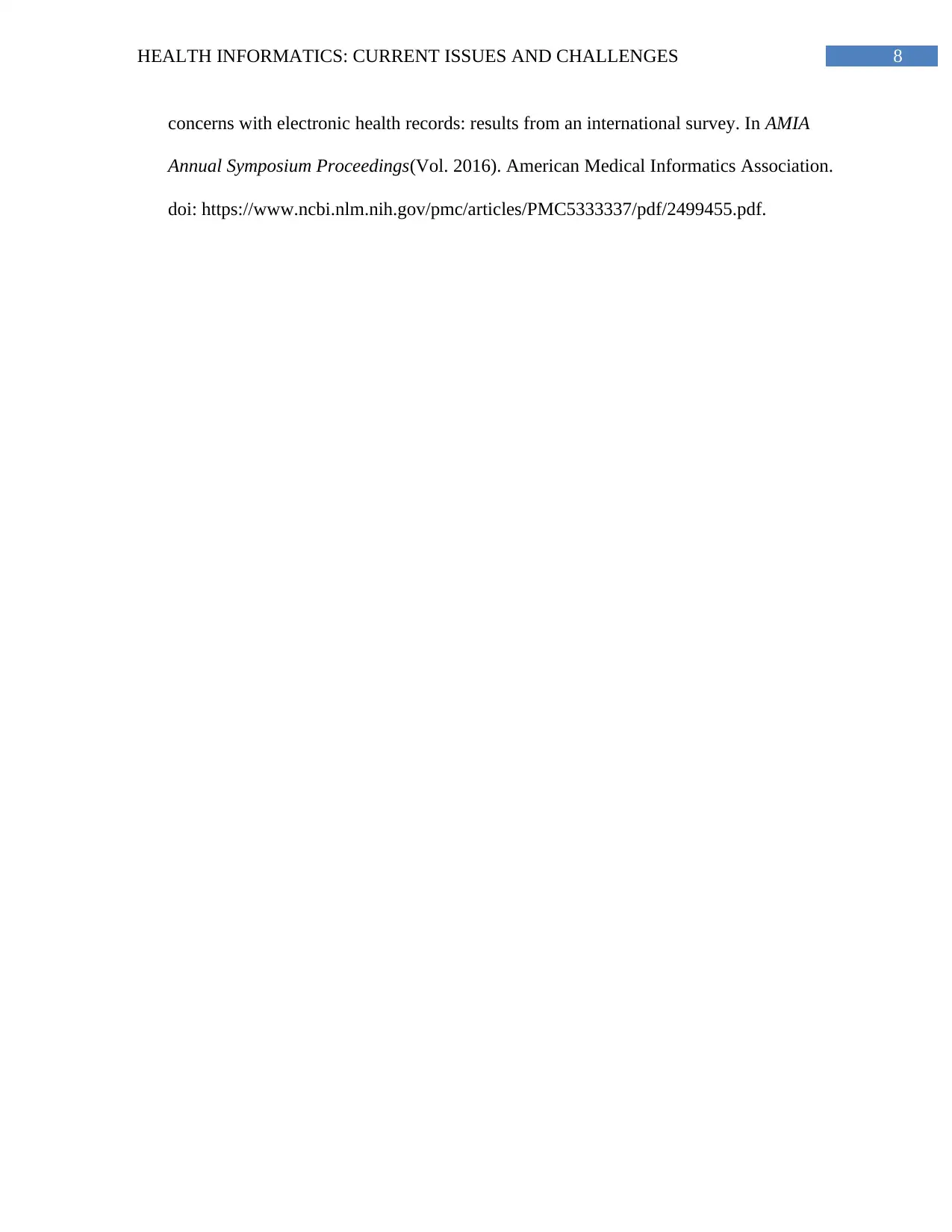
8HEALTH INFORMATICS: CURRENT ISSUES AND CHALLENGES
concerns with electronic health records: results from an international survey. In AMIA
Annual Symposium Proceedings(Vol. 2016). American Medical Informatics Association.
doi: https://www.ncbi.nlm.nih.gov/pmc/articles/PMC5333337/pdf/2499455.pdf.
concerns with electronic health records: results from an international survey. In AMIA
Annual Symposium Proceedings(Vol. 2016). American Medical Informatics Association.
doi: https://www.ncbi.nlm.nih.gov/pmc/articles/PMC5333337/pdf/2499455.pdf.
⊘ This is a preview!⊘
Do you want full access?
Subscribe today to unlock all pages.

Trusted by 1+ million students worldwide
1 out of 9
Related Documents
Your All-in-One AI-Powered Toolkit for Academic Success.
+13062052269
info@desklib.com
Available 24*7 on WhatsApp / Email
![[object Object]](/_next/static/media/star-bottom.7253800d.svg)
Unlock your academic potential
Copyright © 2020–2025 A2Z Services. All Rights Reserved. Developed and managed by ZUCOL.





